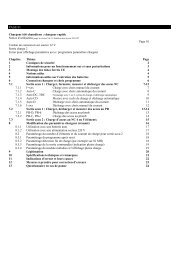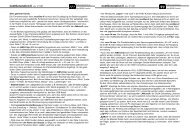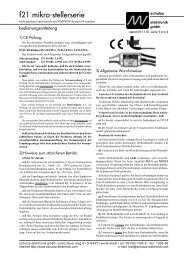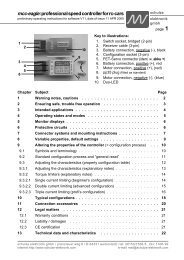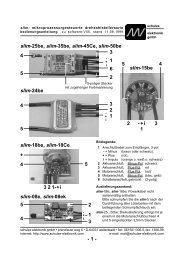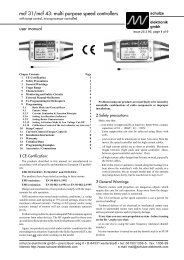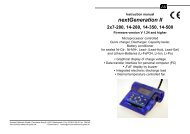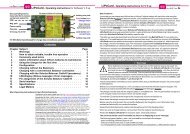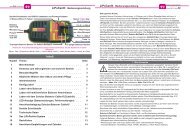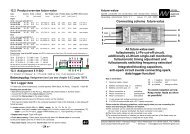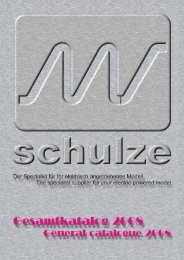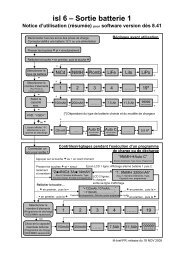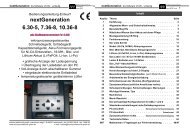ecolader: rapid discharger/charger series - Schulze Elektronik GmbH
ecolader: rapid discharger/charger series - Schulze Elektronik GmbH
ecolader: rapid discharger/charger series - Schulze Elektronik GmbH
You also want an ePaper? Increase the reach of your titles
YUMPU automatically turns print PDFs into web optimized ePapers that Google loves.
<strong>ecolader</strong>: <strong>rapid</strong> <strong>dis<strong>charger</strong></strong>/<strong>charger</strong> <strong>series</strong><br />
Operating instructions for software V1.04, date of issue 05 MAY 1998<br />
8.13 Charge method<br />
Description:<br />
With this function you determine the method<br />
of charging to be used to charge your<br />
packs.<br />
The following methods are available:<br />
Linear charging:<br />
The most commonly used and straightforward<br />
of all methods of charging.<br />
The charge current stays constant for minutes<br />
at a time, and is only interrupted briefly<br />
for the automatic termination system to take<br />
measurements.<br />
If you charge a pack using automatic current<br />
calculation, you may find that a different<br />
charge current is applied after one of the<br />
short measurement pauses, but it will then<br />
be held constant again for a long period.<br />
Pulse charging:<br />
Pulse charging means that the charge current<br />
is divided up into pulses of current. After<br />
each pulse of charge current there follows<br />
a "rest" period in which no current<br />
flows.<br />
To avoid placing too severe a load on the<br />
mains PSU or car battery due to superimposed<br />
pulses, the charge pulses for Battery<br />
1 and Battery 2 are applied alternately.<br />
For this reason the pulsed current for Battery<br />
1 is 1.5 times the average charge current<br />
(soft pulses), and the pulsed current for<br />
Battery 2 is 3 times the average current<br />
(hard pulses).<br />
It is essential that your power supply can<br />
deliver these increased peak currents; this<br />
applies in particular to mains PSUs.<br />
For this reason, pulsed charging applies to<br />
Battery 1 and Battery 2 simultaneously.<br />
Example: Batt 1: 6 A --> 9 A pulsed current,<br />
Batt 2: 5 A --> 15 A pulsed current!<br />
Linear charging with refresh pulses:<br />
The charge process is interrupted at particular<br />
intervals by discharge pulses at the<br />
same rate as the charge current.<br />
Pulse charging with refresh pulses:<br />
The charge is interrupted at particular intervals<br />
by discharge pulses at the same rate<br />
as the pulsed charge current.<br />
schulze<br />
elektronik<br />
gmbh<br />
Page 17<br />
Refresh pulses can be set separately for Battery<br />
1 and Battery 2.<br />
Activating the menu point:<br />
Press the akku x button.<br />
Select:<br />
Press the + or - button.<br />
Select range:<br />
As described on the left.<br />
Confirm selection:<br />
Press enter<br />
Interrupt:<br />
Press esc<br />
Notes on refresh charging:<br />
The discharge pulses are intended to accelerate<br />
the regenerative effect of old batteries,<br />
and reduce the memory effect.<br />
An additional advantage is that the temperature<br />
rise sets in later as the packs approach<br />
the fully charged state. Batteries therefore<br />
stay cooler towards the end of the charge.<br />
During refresh charging you will hear quiet<br />
crackling noises from the battery; this is perfectly<br />
normal and is due to the high-current<br />
discharge pulses.<br />
Important note regarding refresh charging:<br />
It is important to take into account the delayed<br />
temperature rise in a battery by adjusting<br />
the temperature setting to lower values<br />
if you are using temperature charge termination.<br />
Display:<br />
The screen displays various symbols to indicate<br />
the charge method you have selected:<br />
"L" for Linear charging<br />
"P" for Pulse charging<br />
"f " for Refresh charging<br />
The symbols on the screen are slightly<br />
smaller than the usual symbol height, in order<br />
to be able to display the combination<br />
"Lf" and "Pf" in a single display field.<br />
"Two-Batt-Screen"<br />
Line 1 = Battery 1<br />
Line 2 = Battery 2<br />
Pulse charge<br />
Temperature<br />
termination<br />
A1P°ready A1P°ready auto auto C<br />
07:17 07:17 9.19V!3.5A<br />
9.19V!3.5A<br />
Ch. time Battery<br />
voltage<br />
Measure.<br />
pause<br />
Automatic<br />
ch. program<br />
Ch. current<br />
(before the<br />
meas. pause)<br />
Indirect displays: Batt. 2 set to peak termination, as Batt. 1 is set to temp. termin.<br />
Batt. 2 set to pulse charging, as Batt. 1 is being pulse-charged.<br />
schulze elektronik gmbh • prenzlauer weg 6 • D-64331 weiterstadt • tel: 06150/1306-5, fax: 1306-99<br />
internet: http://www.schulze-elektronik.com e-mail: mail@schulze-elektronik.com



